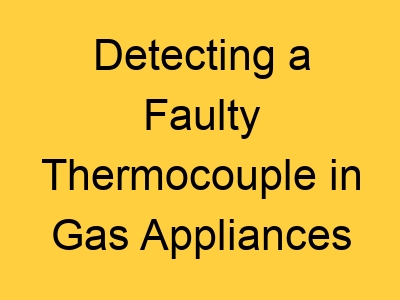Quck answer
A thermocouple is a device used to measure temperature in various applications. If you suspect that your thermocouple is bad, there are a few signs to look out for. Firstly, if your gas appliance is not staying lit, it could be a sign of a faulty thermocouple. Another indication is if the pilot light keeps going out, even after relighting it. Additionally, if you notice a drop in the temperature readings or inconsistent readings, it may be due to a malfunctioning thermocouple. Lastly, if you have ruled out other possible issues, such as a gas supply problem, and your appliance continues to have trouble, it’s likely time to replace the thermocouple.
If you own a gas water heater or a gas wall heater, there is a thermocouple that plays a significant role in your appliance’s operation. This device works together with a standing pilot, which is a small flame that burns while the equipment is in use.
The thermocouple’s primary job is to keep the pilot lit. It accomplishes this by transmitting a small electric current to a sensor on the gas valve, signaling it to remain open. The thermocouple can do this because it contains two different metals in its probe, and a voltage is generated when one of them heats up, known as the Seebeck Effect.
However, when the thermocouple wears out, the pilot won’t stay lit, and the equipment won’t function. But, if you’re having trouble keeping the pilot lit, the thermocouple might not be at fault. Here are some tips to pinpoint a faulty thermocouple as the cause of the problem.
Pilot Lights But Goes Out
If the pilot won’t light at all, the thermocouple is most likely not the issue. The procedure for lighting a standing pilot always involves lighting the flame and then manually holding in the gas valve to keep the flame burning and give the thermocouple time to heat up. If you can’t get the flame to light, there’s probably an obstruction in the pilot tube.
If the flame lights and goes out when you let go of the gas control knob after holding it in for 20 to 30 seconds, that’s a sign of a faulty thermocouple. Before concluding that the thermocouple is at fault, examine the pilot flame. If it appears small and has an orange-yellow tinge, it may be too weak to heat the thermocouple. The likely problem, again, is an obstruction in the pilot tube.
Before Blaming the Thermocouple Try This
The pilot flame must be big and hot enough to heat the thermocouple to the temperature that generates enough voltage to signal the gas valve. Sometimes, the problem is that the thermocouple probe is too far from the flame. You can eliminate this possibility if there’s enough room for you to reach in your hand and reposition the probe closer to the flame. You can also eliminate obstructions in the pilot tube as a possible cause by turning off the gas, unscrewing the pilot tube from the gas valve, and blowing compressed air from a can through the tube. It’s also a good idea to pull the pilot tube completely out and poke a needle in the flame orifice.
Test the Thermocouple
Gas appliance thermocouples have a standard design. A gas water heater in Boise, Baton Rouge, Buffalo, or Boston uses a thermocouple that includes a probe attached to a copper tube that screws into a port on the gas valve. If the thermocouple is working correctly, you should measure 30 to 40 millivolts of voltage at the connection end of the tube when the pilot flame is on. You can test this yourself using a multimeter, but you may need a helper to keep the pilot flame burning while you do it.
To begin the test, remove the thermocouple from the gas valve. Adjust the multimeter to measure millivolts and ignite the pilot light. Ask your partner to hold down the gas control knob to maintain the flame. Once the probe has heated up, which should take approximately one minute, place one lead on the thermocouple shaft and the other on the connector. If the measurement is below 25 millivolts, the thermocouple is defective and must be substituted.
FAQ
1. How can I tell if a thermocouple is bad?
A thermocouple is a device that measures temperature by generating a small voltage. If your gas appliance is not staying lit or the pilot light keeps going out, it may be a sign of a bad thermocouple. To check if the thermocouple is the problem, start by turning off the gas supply. Then, remove the thermocouple from the gas valve and use a multimeter to measure its voltage. If the reading is zero, it means the thermocouple is bad and needs to be replaced.
2. Are there any signs of a faulty thermocouple?
Yes, there are a few signs that indicate a faulty thermocouple. If the pilot light of your gas appliance goes out frequently or the flame appears weak and yellow instead of strong and blue, it could be due to a bad thermocouple. Additionally, if your gas appliance fails to stay lit or takes a long time to heat up, it may be another indication of a faulty thermocouple. It is important to address these issues promptly to ensure the safe and efficient operation of your gas appliance.
3. Can a bad thermocouple be fixed or does it need to be replaced?
Generally, a bad thermocouple cannot be fixed and needs to be replaced. Over time, thermocouples can wear out or get damaged, causing them to lose their ability to generate voltage accurately. When this happens, it is best to replace the thermocouple to ensure the proper functioning of your gas appliance. It is recommended to consult the manufacturer’s instructions or seek professional help for the correct replacement procedure. Regular maintenance and inspection of the thermocouple can help detect any potential issues early and prevent them from causing further problems.

